
Major-General Patrick Ronayne Cleburne was a senior officer in the Confederate States Army who commanded infantry in the Western Theater of the American Civil War.
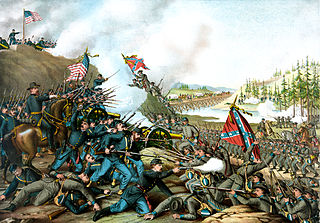
The Battle of Franklin was fought on November 30, 1864, in Franklin, Tennessee, as part of the Franklin–Nashville Campaign of the American Civil War. It was one of the worst disasters of the war for the Confederate States Army. Confederate Lieutenant General John Bell Hood's Army of Tennessee conducted numerous frontal assaults against fortified positions occupied by the Union forces under Major General John Schofield and was unable to prevent Schofield from executing a planned, orderly withdrawal to Nashville.

Hollywood Cemetery is a historic rural cemetery located at 412 South Cherry Street in the Oregon Hill neighborhood of Richmond, Virginia. It was established in 1847 and designed by the landscape architect John Notman. It is 135-acres in size and overlooks the James River. It is one of three places in the United States that contains the burials of two U.S. Presidents, the others being Arlington National Cemetery and United First Parish Church.

Oakland Cemetery is one of the largest cemetery green spaces in Atlanta, Georgia, U.S. Founded as Atlanta Cemetery in 1850 on six acres (2.4 hectares) of land southeast of the city, it was renamed in 1872 to reflect the large number of oak and magnolia trees growing in the area. By that time, the city had grown and the cemetery had enlarged correspondingly to the current 48 acres (190,000 m2). Since then, Atlanta has continued to expand so that the cemetery is now located in the center of the city. Oakland is an excellent example of a Victorian-style cemetery, and reflects the "garden cemetery" movement started and exemplified by Mount Auburn Cemetery in Massachusetts.

Crown Hill National Cemetery is a U.S. National Cemetery located in Indianapolis, Marion County, Indiana. It was established in 1866 on Section 10 within Crown Hill Cemetery, a privately owned cemetery on the city's northwest side. Administered by the United States Department of Veterans Affairs, the National Cemetery encompasses 1.4 acres (0.57 ha) and serves as a burial site for Union soldiers who fought in the American Civil War.

States Rights Gist was a lawyer and militia general in South Carolina, and later a Confederate Army brigadier general during the American Civil War. He gained prominence during the war but was killed at the Battle of Franklin on November 30, 1864. Gist was named after the Southern states' rights doctrine of nullification, reflecting the political beliefs of his father, Nathaniel Gist, a follower of John C. Calhoun.

Carnton is a historic plantation home built in 1826 in Franklin, Williamson County, Tennessee, United States. The property, comprising 1,420 acres (5.7 km2), played an important role during and immediately after the Battle of Franklin during the American Civil War. Carnton was situated less than one mile (1.6 km) from the location of the 1864 battle's Union Army eastern flank, and it became the principal temporary field hospital for tending the wounded. More than 1,750 Confederate soldiers lost their lives at Franklin, and on Carnton's back porch four deceased Confederate generals' bodies were laid out for a few hours after the battle. The life of Carrie McGavock, who lived at Carnton during the civil war, was the subject of a best-selling novel in 2005 by Robert Hicks, entitled The Widow of the South. The house was listed on the National Register of Historic Places in 1973, and became a museum managed by The Battle of Franklin Trust, a non-profit organization.
Franklin Battlefield was the site of the Second Battle of Franklin, which occurred late in the American Civil War. It is located in the southern part of Franklin, Tennessee, on U.S. 31. It was declared a National Historic Landmark in 1960.

Myrtle Hill Cemetery is the second oldest cemetery in the city of Rome, Georgia. The cemetery is at the confluence of the Etowah River and Oostanaula River and to the south of downtown Rome across the South Broad Street bridge.
Patrick R. Cleburne Confederate Cemetery is a memorial cemetery located in the city of Jonesboro, Georgia, United States. It was named in honor of General Patrick Cleburne. This cemetery was a burial site for Confederate soldiers who died in the Battle of Jonesboro in 1864. This cemetery is open daily until dusk. It is one of six Confederate cemeteries maintained by the Georgia Building Authority.

The Lotz House is a two-story frame house built in 1858 in the central Tennessee town of Franklin. The house is significant for being in the epicenter of the Battle of Franklin in the American Civil War in 1864.

A Ladies' Memorial Association (LMA) is a type of organization for women that sprang up all over the American South in the years after the American Civil War. Typically, these were organizations by and for women, whose goal was to raise monuments in Confederate soldiers honor. Their immediate goal, of providing decent burial for soldiers, was joined with the desire to commemorate the sacrifices of Southerners and to propagate the Lost Cause of the Confederacy. Between 1865 and 1900, these associations were a formidable force in Southern culture, establishing cemeteries and raising large monuments often in very conspicuous places, and helped unite white Southerners in an ideology at once therapeutic and political.

Randal McGavock (1766–1843) was an American politician and Southern planter in Nashville, Tennessee. Identifying as a Jeffersonian Republican, he served as the Mayor of Nashville, Tennessee from 1824 to 1825.
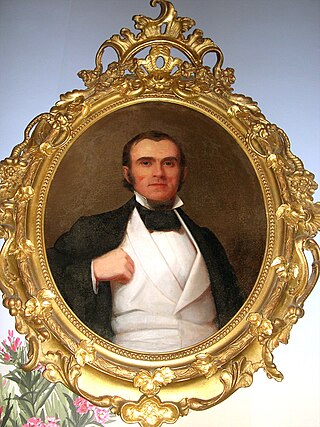
Col. John McGavock (1815–1893) was an American heir and Southern planter.
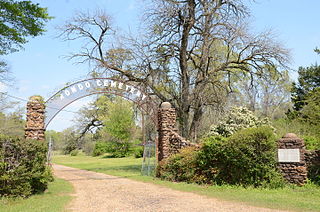
The Old Rondo Cemetery is located at the junction of McClure Road and Cobb Lane in Rondo, a small community in Miller County just northeast of Texarkana, Arkansas. The cemetery is best known for the burial site at its center, where the remains of 85 Confederate Army soldiers are buried. In 1862, during the Union Army advance on Little Rock, Confederate troops stationed at Rondo were swept up in a measles epidemic. The 19th Texas Infantry Regiment had seven companies stationed at Rondo, and most of the dead came from its ranks. The 85 dead were disinterred from their original graves and reburied in the Rondo Cemetery after the war. In 1931 the Texarkana chapter of the United Daughters of the Confederacy received federal funding for the purchase of the plot and the placement of memorial markers. There are 17 markers, one for every five of the unknown soldiers, as well as a sandstone monument placed in 1962 and a historical marker placed in the 1990s on the plot, which is set off from the rest of the cemetery by a low concrete boundary wall.

Mary Ann Harris Gay was an American writer and poet from Decatur, Georgia, known for her memoir Life in Dixie During the War (1897) about her life in Atlanta during the American Civil War. Author Margaret Mitchell said Gay's memoir inspired some passages in her novel Gone with the Wind (1936). Gay also published a book of poetry in 1858, which she republished after the war to raise money to help support her mother and sister.
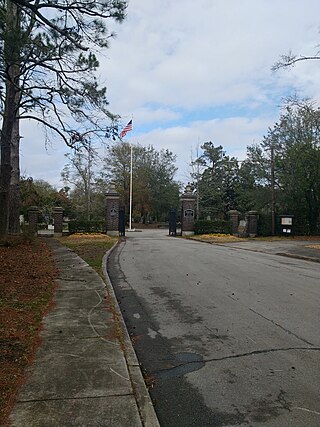
Oakdale Cemetery is a cemetery in Wilmington, North Carolina that dates from the 19th century.
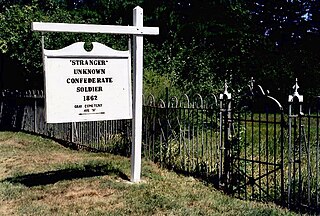
The Unknown Confederate Soldier of Gray, Maine is an unidentified uniformed man whose body was mistakenly sent to the family of fallen Union soldier Charles H. Colley in Gray, Maine in 1862 during the American Civil War.

Mariah Bell Otey Reddick (1832–1922) was an American midwife, nurse, and domestic worker who was held as a slave at Carnton Plantation in Franklin, Tennessee. She worked for the family of Colonel John McGavock for four generations, both as a house slave and as a freedwoman. At Carnton, Reddick was the head of the household staff and also worked as a maid, nanny, and midwife for the family. During the American Civil War, she was sent to Montgomery, Alabama to stay at the home of Varina Davis' mother, Margaret Kempe Howell. During this time, she was employed as a nurse by the surgeon W.M. Gentry. After the war, Reddick was a favorite midwife of the women of Franklin's high society.

Carrie Winder McGavock was an American slave owner and the caretaker of the McGavock Confederate Cemetery at Carnton, a historic plantation complex in Franklin, Tennessee. Her life was the subject of a 2005 best-selling novel by Robert Hicks, entitled The Widow of the South.





















